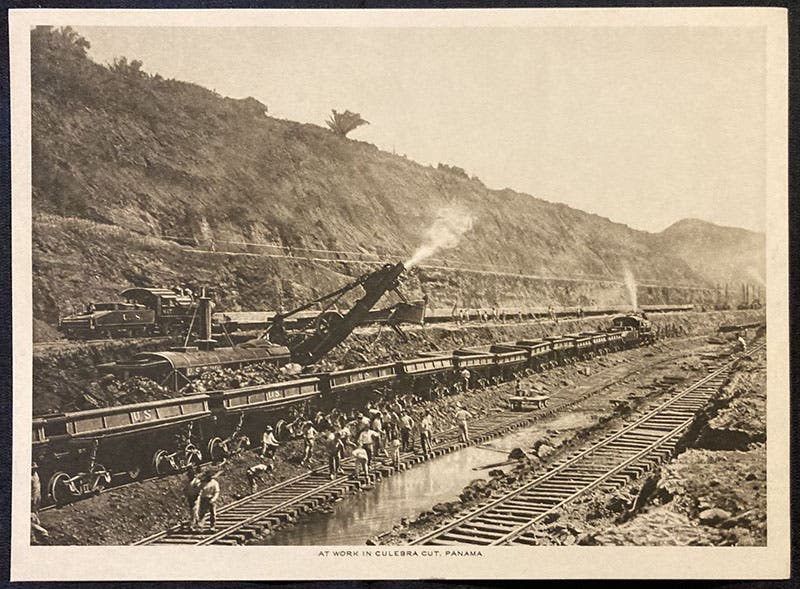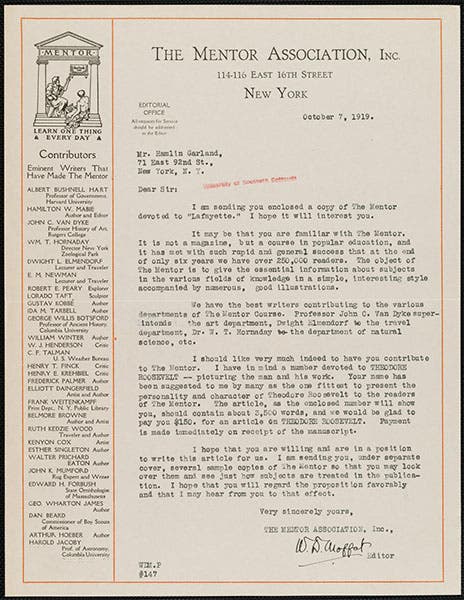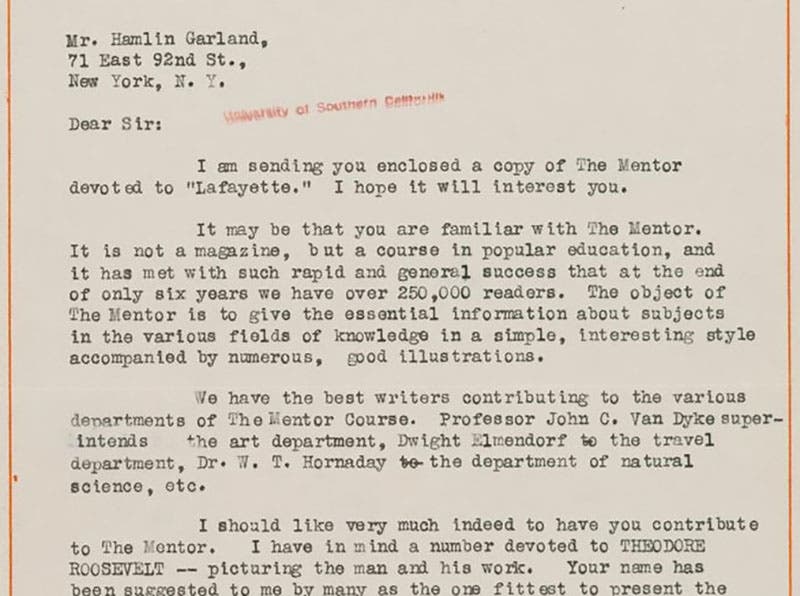Scientist of the Day - William D. Moffat

“The Conquest of the Air,” issue of The Mentor for Apr. 1, 1914, with one of the six loose rotogravure plates, this one showing the Wright Brothers’ Flyer in 1903 (author’s collection)
William David Moffat, a publisher, died Sep. 29, 1946, at the age of 81. Moffat went to Princeton and, while still an undergraduate, began publishing books for adolescent boys. Upon graduation, he took a job at Scribners, worked there for 20 years, and then founded his own publishing company. I don't know what kind of books or periodicals he published for the first 7 years, but in 1912, he decided to begin publishing educational pamphlets. He founded an organization that he called the Mentor Association. It has been described as a think tank, but it seems more like a book club, for the sole function, it appears, of the Mentor Association, was to publish, for its membership, a magazine, The Mentor, the first issue of which appeared on Feb. 17, 1913. Each issue was devoted to a single specific topic, such as "The Panama Canal," or “Art of the Vatican,” and it contained within its covers a short, 10-page printed leaflet, and 6 loose rotogravure plates, with lengthy explanatory captions printed on the back. At its onset, The Mentor was a weekly, but it quickly became a biweekly. Still, by 1920, it had published almost 200 issues, on a wide variety of topics.
The Mentor covered all of the humanities, so most of the issues did NOT have a scientific theme. But some did, which makes it fun to collect, if you happen to be a historian of science, as I am. I own just 6 issues, which I bought one by one on eBay, and I find the issues fascinating – tiny microcosms of graphic information. Moffat, who was editor-in-chief, sought out the best authorities he could get to write the text part of each issue. For example, the issue on “Prehistoric Animal Life” (Aug. 15, 1917; fifth image) was written by William D. Matthew, the eminent paleontologist at the American Museum of Natural History, and it was illustrated by Charles Knight, also at the AMNH, and the foremost dinosaur illustrator in the world at the time (although the illustrations included were ones Knight had painted 20 years earlier).

“The Story of the Lens,” issue of The Mentor for Sep. 1, 1916, showing four of the six loose rotogravure plates and the pamphlet (author’s collection)

Digging the Culebra Cut for the Panama Canal, one of the six loose plates in “The Panama Canal,” issue of The Mentor for May 26, 1913 (author’s collection)
Sometimes the scope is too broad, as with the issue "The Story of the Lens," which attempts to talk about microscopes, telescopes, telephoto lenses, and lens grinding in one short article (third image), but the issues are always interesting, and it is nice to be able to remove the plates, turn them over and read the verso, and then turn them over again to view the photos in a new light. The issues on "The Conquest of the Air" (Apr. 1, 1914) and "The Panama Canal” (May 26, 1913) are outstanding; the former has historic and hard to find photos of a Curtis Flying Boat and a Zeppelin, as well as the Wright Brothers Flyer taking to the air (first image), and the latter contains dramatic rotogravures of the digging of the Culebra Cut for the Panama Canal project (fourth image).

“Prehistoric Animal Life,” issue of The Mentor for Aug. 15, 1917, with the first page of the text by William D. Matthew, and two plates of paintings by Charles Knight, both at the American Museum of Natural History (author’s collection)
I am not a serious collector of anything, so I have not made a systematic search for science-themed issues of The Mentor, and thus I have no idea how many there are. But I do know that after 1920, things changed, as color was added, the issues got thicker and less frequent, and the single-themed issue was abandoned. The magazine was sold several times, Moffat was replaced as editor at some point, and publication ceased early in 1931. So I am sticking to the first eight years of publication, if I decide to look for more. If you care to acquire any issues yourself, be advised that, because the plates were loosely inserted, copies for sale often lack one or more plates, so look for a plate count. I am not certain that every issue had 6 plates, but all six of my issues do.

The five issues of The Mentor used for this post, ranging in date from 1913 to 1919 (author’s collection)
And of course, you don't have to collect science-themed issues. You might choose European Painting, or Geography, or Famous Americans, or Wine, and I am sure you would find quite a few issues relevant to each theme. You can also buy just individual rotogravures, but what’s the fun of that.
I found in the archives of the University of Southern California, a letter written by Moffat to a writer named Hamlin Garland, dated Oct. 7, 1919 (seventh image), asking if Mr. Garland would care to contribute the text for an issue on “Theodore Roosevelt”, for which he would be paid $150 (quite a sum for a 10-page essay in 1919). The second paragraph is interesting (see a detail of the letter, eighth image), because here, Moffat explains that The Mentor is not a magazine but a course of education, and that it has over 250,000 readers, a number that far exceeded the number of subscribers, but may be legitimate. Garland took the bait; if you search eBay for “Mentor Theodore Roosevelt,” you will often find a copy for sale, issue no. 196, titled “Theodore Roosevelt,” dated Feb. 2, 1920, and written by Hamlin Garland.
William B. Ashworth, Jr., Consultant for the History of Science, Linda Hall Library and Associate Professor emeritus, Department of History, University of Missouri-Kansas City. Comments or corrections are welcome; please direct to ashworthw@umkc.edu.









